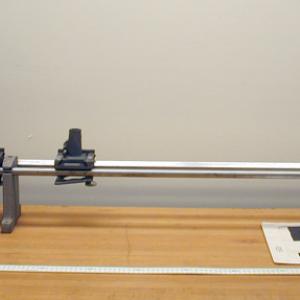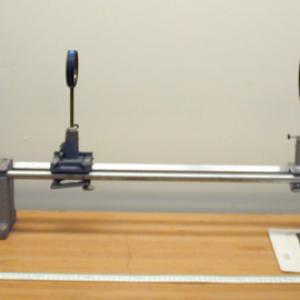College of Liberal Arts & Sciences
6A70.20 - Telescopes - Optical Rail Models
Place the #5 poster on the far wall of the lecture room. Without looking through the lenses point the camera at the #5 and focus. Place the +20 and +76 lens on the indicated places on the rail and point the system toward the #5. The field of view here should be large but the #5 will be upside down (this is what we refer to as a Keplerian telescope).
Now replace the +20 lens with the - 20 lens and move the lenses to the new positions. Now observe that the field of view is very narrow but the #5 is right side up (this is what we refer to as a Galilean telescope setup).
- Christopher Sirola, "Galileo’s Telescope", TPT, Vol. 57, #1, Jan. 2019, p. 56.
- Max Ziegler, "Galilean Refractor in an Aquarium", TPT, Vol. 50, #4, Apr. 2012, p. 251.
- Maurizio Vannoni, Giuseooe Molesini, Andrea Sordini, and Samuele Straulino, "A Mechanical Analogue of the Refracting Telescope", TPT, Vol. 49, #4, Apr. 2011, p. 236.
- A.J. Cox and Alan J. DeWeerd, "The Image Between the Lenses: Activities with a Telescope and a Microscope", TPT, Vol. 41, #3, Mar. 2003, p. 176.
- Gene Byrd and Mark Graham, "Camera and Telescope Free-for-All!", TPT, Vol. 37, #9, Dec. 1999, p. 547.
- Mark L. Biermann and Lois A. A. Biermann, "When the f / # is Not the f / #", TPT, Vol. 34, #5, May 1996, p. 312.
- Robert P. Lanni, "Optics Experiments by Armstrong", TPT, Vol. 5, #2, Feb. 1967, p. 84.
- H. L. Armstrong, "An Experiment on Optical Devices", TPT, Vol. 4, #7, Oct. 1966, p. 323.
- Rick Beyer, "Lippershey's Looker", The Greatest Science Stories Never Told, p. 14.
- John H. Moore, Christopher C. Davis, and Michael A. Coplan, "Lenses and Lens Systems", Building Scientific Apparatus 2nd Edition, p. 143 - 144.
- Raymond Bruman, "Lens Table", Exploratorium Cookbook I, p. 11.1 - 11.4.
- Gordon McComb, "Laser Optics Experiments", Lasers, Ray Guns, & Light Cannons, p. 133.
- Bobby Mercer, "Star Gazer", Junk Drawer Physics, p. 96.
- C. Harvey Palmer, "Experiment A15: The Telephoto Lens, The Galilean Telescope, and the Barlow Lens", Optics - Experiments and Demonstrations, John Hopkins Press, 1962.
- C. Harvey Palmer, "Experiment A16: The Refracting Telescope", Optics - Experiments and Demonstrations, John Hopkins Press, 1962.
- "8. The Galilean Telescope", Experiments in Optics, Part 1, J. Klinger Scientific Apparatus Corp., Bulletin 101.
- "7, The Astronomical Telescope", Experiments in Optics, Part 1, J. Klinger Scientific Apparatus Corp., Bulletin 101.
- T. D. Rossing and C. J. Chiaverina, "4.10, Telescopes and Microscopes", Light Science, Physics and Visual Arts, p. 95.
- "Magnifying Power and Resolving Power of a Telescope", Selective Experiments in Physics, CENCO, 1962.
- "Simple Telescopes - Magnifying Power", Selective Experiments in Physics, CENCO, 1962.
Disclaimer: These demonstrations are provided only for illustrative use by persons affiliated with The University of Iowa and only under the direction of a trained instructor or physicist. The University of Iowa is not responsible for demonstrations performed by those using their own equipment or who choose to use this reference material for their own purpose. The demonstrations included here are within the public domain and can be found in materials contained in libraries, bookstores, and through electronic sources. Performing all or any portion of any of these demonstrations, with or without revisions not depicted here entails inherent risks. These risks include, without limitation, bodily injury (and possibly death), including risks to health that may be temporary or permanent and that may exacerbate a pre-existing medical condition; and property loss or damage. Anyone performing any part of these demonstrations, even with revisions, knowingly and voluntarily assumes all risks associated with them.

